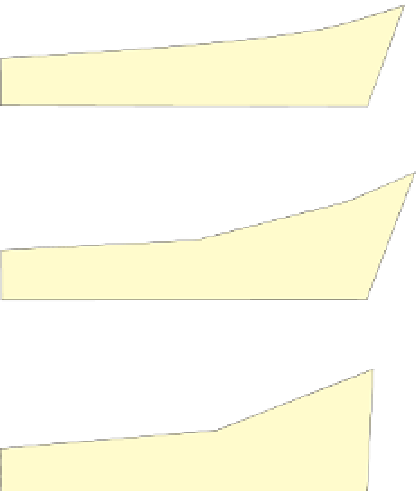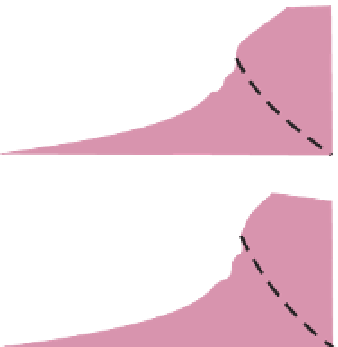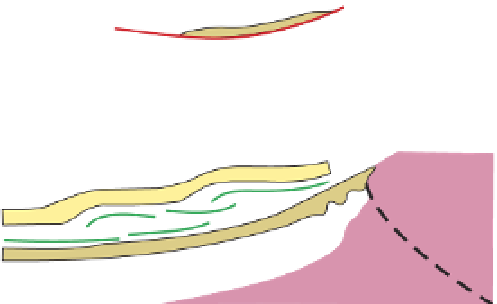Geology Reference
In-Depth Information
Figure 9.2
Gravity-gliding of Alpine nappes. Three stages in the evolution of
the Mesozoic Tinée nappes in the Alpes Maritimes of SE France, from an
interpretation by R.H. Graham (1981).
1, 2:
upthrust of the Argentera massif
(Palaeozoic basement) causes gravitational sliding of Triassic to Cretaceous
strata on detachment faults within a ductile Triassic salt layer in two stages,
followed by (
3
) displacement on a listric normal fault. Am, Argentera massif; P,
pre-Triassic strata; Tr, Triassic; Tn, Tithonian (Uppermost Jurasssic); U, Upper
Cretaceous. Vertical relief ~3 km; horizontal length of section, ~7 km.
U
3km
Tn
Tr
P
Am
1
'normal'
continental
crust
'normal'
continental
crust
orogen
2
sl
sl
crust
mantle
100km
3
Figure 9.3
Gravitational spreading. Diagrammatic representation of the
concept of gravity spreading on the scale of an orogen, or mountain belt:
the thickened crust (which can be as much as 80 km compared to an
average continental crust thickness of ~33 km) is gravitationally unstable;
the resulting stresses squeeze the over-thickened crust, which 'flows'
laterally outwards.
largely ductile deformation through-
out the moving sheet in response to
a gravitationally derived stress state.
On the scale of the whole mountain
belt, the latter process has also been
described as
orogen collapse
(Figure
9.3). On this scale, the over-thickened
crust can be viewed as if it is a ductile
medium responding to the gravita-
tional stress, which acts to squeeze the
crust, by 'flowing' sideways in order
to restore the more stable gravita-
tional state of 'normal' crustal thick-
ness. In detail, of course, the resulting
deformation is highly variable: brittle,
fault-controlled in the upper regions
and more ductile creep in the lower.
Glacial flow structure
One of the best examples of gravi-
tational control can be seen in the
movement of glaciers. Ice, moving
down-slope under gravity, deforms in
the solid state, but at a rate that is more
convenient for us to study than that of
most other rock materials. Structures
produced during glacial flow include
both folds and faults. A spectacular
example of flow folds is displayed in
Figure 6.8, where marker bands of differ-
ently coloured sediment that have been
washed onto the glacier surface have
been deformed into a series of similar
folds. Fault structures in the form of
extensional crevasses also form on
glaciers where they move over convex
slopes, and these are also deformed by
differential flow into similar folds, as
seen towards the top right of Figure 6.8.
In both these cases, the flow direction
is parallel to the direction of transport
of the glacier, but transverse to the
structures that have been deformed.
Salt tectonics
Salt, like ice, has a low viscosity com-
pared to most rocks and is therefore
able to flow under relatively small
stress differences and at geologi-
cally fast rates. Common salt (
halite
,
or sodium chloride) and
anhydrite
(magnesium sulphate) are the com-
monest members of a group of miner-
als, termed
evaporites
, which form
by evaporation in warm shallow
seas. Evaporite layers are particularly



































































Search WWH ::

Custom Search